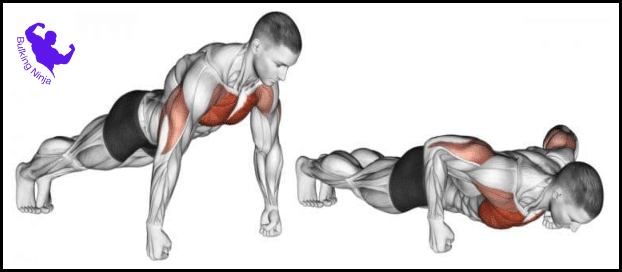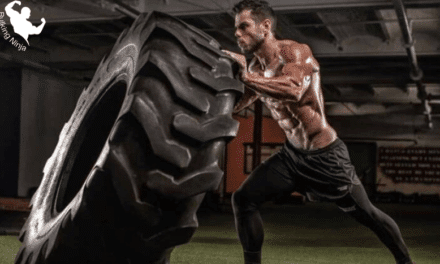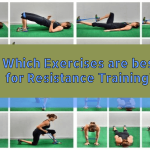In the realm of fitness and strength training, the debate rages on: Are knuckle push-ups more effective than their traditional counterparts? As we strive to push our physical limits and achieve optimal results from our workouts, it’s crucial to dissect and understand the nuances of different exercise variations. Knuckle push-ups, a staple of martial arts and military training, have garnered attention for their potential benefits and unique challenges.
In this exploration, we delve into the science behind knuckle push-ups, comparing their advantages and drawbacks to traditional palm-based push-ups. By the end, you’ll have a clearer picture of whether knuckle push-ups deserve a place in your fitness routine or if they’re just another passing trend.
Table of Contents
Are Knuckle Push Ups More Effective?
In the types of push-up variations, the knuckle push-up stands out as an intriguing option. This unique variation involves forming fists instead of placing palms on the floor, setting it apart from the standard push-up.
While the benefits extend beyond non-sports contexts, such as martial arts and contact sports, where the increased range of motion can be advantageous, it’s important to differentiate the pros and cons. For martial artists and contact sport athletes, knuckle push-ups could potentially offer enhanced wrist stability and toughness, aligning with the demands of their disciplines.
However, for the average fitness enthusiast, the standard push-up remains a versatile and effective choice. By exploring the nuances between these variations, we can gain a deeper understanding of their applicability and potential benefits, further refining our approach to optimizing strength and fitness. More read about Breakfast is important for gaining Muscles.
What is Knuckle Push-Ups?

When delving of bodyweight resistance exercises, the knuckle push-up emerges as a distinctive and advantageous variation of the traditional push-up. This compound exercise requires the exerciser to encase their hands in fists, introducing a subtle yet impactful difference.
Particularly esteemed by martial artists and those seeking enhanced forearm and wrist mobility, knuckle push-ups offer a less taxing approach on the arm’s joints. This makes them an optimal choice for both athletes and fitness enthusiasts aiming to stimulate hypertrophy and bolster the triceps brachii, pectoral muscle group, and deltoid muscle group.
In the pursuit of maximizing benefits, the key lies in tailored programming and deliberate, controlled repetitions. Athletes and martial artists engaging in knuckle push-ups for conditioning purposes can attest to their effectiveness in building wrist strength and resilience.
Furthermore, individuals aiming to extend their range of motion can augment their regimen with additional equipment, enabling deeper eccentric movements during push-ups. In the grand tapestry of exercise variations, knuckle push-ups stand as a testament to the multifaceted nature of physical development and strength enhancement. Read more about Inline pushups.
How to do it
Performing knuckle push-ups involves a few key steps to ensure proper execution and minimize the risk of injury. Follow these instructions for effective knuckle push-ups:
Starting Position
Begin in a standard push-up position with your hands directly beneath your shoulders and your body forming a straight line from head to heels. Instead of having your palms flat on the ground, create fists with your fingers and rest on your knuckles.
Hand Placement
Position your fists slightly wider than shoulder-width apart for stability. Keep your fingers curled and your knuckles aligned.
Engage Core Muscles
Tighten your core muscles to maintain a stable plank position throughout the exercise.
Descent
Lower your body towards the ground by bending your elbows. Keep your body straight and maintain proper form.
Depth and Range
Lower yourself until your chest is just above the ground or at a comfortable depth. The range of motion might be slightly different compared to regular push-ups due to the knuckle contact.
Push Up
Push through your knuckles and extend your elbows to raise your body back to the starting position. Exhale as you push up.
Repetition
Perform the desired number of repetitions while maintaining proper form and control. Focus on a slow and controlled movement to maximize muscle engagement.
Cooldown
After completing your knuckle push-ups, gently release your fists and shake out your hands and wrists to relieve any tension.
Remember, like any exercise, it’s important to start with a suitable number of repetitions and gradually increase intensity as your strength improves. If you’re new to knuckle push-ups or experience discomfort, consider practicing on a soft surface or using push-up handles to reduce the pressure on your knuckles. Always prioritize proper form to prevent injury and optimize the benefits of this challenging variation. Let’s start One-Arm pushups for gain muscle.
What Muscles Do Knuckle Pushups Work?

Knuckle push-ups target a similar set of muscles as traditional push-ups but with some variations due to the hand positioning. Here are the primary muscle groups that knuckle push-ups work:
Chest Muscles (Pectorals)
Both the upper and lower pectoral muscles are engaged as you lower and push your body weight during knuckle push-ups. The unique hand position can emphasize slightly different areas of the chest compared to standard push-ups.
Shoulder Muscles (Deltoids)
The deltoid muscles, which wrap around the shoulder joint, are involved in stabilizing and controlling the movement during knuckle push-ups. They play a role in both the descent and the ascent.
Triceps
The triceps brachii muscles at the back of your upper arms are heavily engaged during the pushing phase of knuckle push-ups. The hand position may place slightly different stress on the triceps compared to regular push-ups.
Core Muscles
The muscles of your core, including the rectus abdominis, obliques, and transverse abdominis, work to maintain stability and a straight body position throughout the exercise.
Forearm Muscles
Since you’re resting on your knuckles, the muscles of your forearms, particularly the flexor muscles that control finger and wrist movement, are activated to support your hand positioning.
Wrist Stabilizers
Knuckle push-ups require increased wrist stability, engaging the stabilizing muscles of the wrist joint and helping to enhance wrist strength.
Overall, knuckle push-ups provide a unique challenge that can help improve wrist strength and stability, making them particularly beneficial for martial artists and individuals looking to enhance their hand and forearm conditioning. Let’s Start Your Bulking Journey with Best Easy High Protein Breakfasts for Muscle Building.
What Are Benefits Of Knuckle Push-Ups?
When exploring the realm of bodyweight exercises, the spotlight often falls on knuckle push-ups, a variation that offers a unique array of benefits. These push-ups, with their distinctive hand positioning and increased range of motion, provide a challenging yet effective means of activating various muscle groups.
By engaging muscles under increased time under tension, knuckle push-ups stimulate gains in muscle size and strength, making them a valuable addition to any fitness routine. The emphasis on forearm muscles and grip strength, crucial for day-to-day activities like carrying groceries or opening a jar, sets knuckle push-ups apart as a holistic training method. Futher more study Fingertip Push ups for Grow Muscle.
Maximizing Muscle Activation and Defining Your Physique
Knuckle push-ups prove particularly effective in engaging key muscle groups that might receive less attention during conventional push-ups. The activation of scapular and rotator cuff muscles, essential for shoulder stability, highlights the well-rounded nature of this exercise. This engagement extends to the chest, triceps, and forearms, fostering muscle development that not only enhances strength but also helps define a balanced and impressive physique.
A Gentle Alternative and Strengthening Solution
For individuals who may experience strain and discomfort during standard push-ups due to wrist mobility issues or joint sensitivities, knuckle push-ups emerge as a gentle alternative. By minimizing strain on the wrists and offering a larger surface area for balance, these push-ups reduce the risk of pain and discomfort. Moreover, they serve as an effective solution for martial artists and combat sports practitioners, conditioning the skin on the knuckles for resilience and reinforcing the hands for impact.
Embracing Progression and Mastery
To fully harness the benefits of knuckle push-ups, a systematic approach to progression is vital. Start on padded surfaces to acclimate the skin, gradually transitioning to rougher terrains as the calloused skin becomes resilient. This methodical progression mirrors the principles of mastery observed in martial arts and combat training, allowing practitioners to refine their technique and strengthen their bodies over time.
In essence, knuckle push-ups stand as a testament to the versatility and effectiveness of bodyweight exercises. Their multifaceted benefits encompass muscle activation, joint-friendly alternatives, and skillful progression, making them an indispensable tool for both fitness enthusiasts and individuals pursuing martial arts excellence alike.
Knuckle Push-Ups Variations
Exploring Advanced Variations: Diamonds Knuckle Push-Ups and Beyond
In the realm of bodyweight exercises, the evolution of traditional push-ups has introduced a diverse array of variations that challenge and refine our physical capabilities. One such intriguing variation is the Diamond Push up,s Knuckle Push-Up, a dynamic and advanced adaptation that targets specific muscle groups while enhancing overall strength and control.
Mastering the Diamonds Knuckle Push-Up
The Diamonds Knuckle Push-Up involves a subtle yet impactful alteration to hand placement, requiring the formation of a diamond shape with the thumbs and index fingers.
This shift in hand positioning not only intensifies the engagement of the triceps but also demands increased stability and balance. The added challenge of balancing on a smaller contact area enhances the activation of forearm muscles and grip strength, making it a formidable exercise for those seeking to amplify their upper body conditioning.
Precision and Progression
Executing Diamonds Knuckle Push-Ups necessitates precision and controlled movement. As you descend, the diamond shape guides your elbows, promoting a triceps-centric contraction. This emphasis on the triceps not only promotes muscle development but also contributes to the aesthetics of well-defined arm muscles.
Beyond Diamonds: Exploring Further Variations
Once proficient in Diamonds Knuckle Push-Ups, enthusiasts can explore an array of advanced variations. Incorporating plyometric elements, such as explosive claps or alternating hand positions, injects an element of athleticism and power. Additionally, introducing elevation by placing the feet on an elevated surface further intensifies the exercise, requiring enhanced core stability and upper body strength.
Customizing Your Workout Regimen
Integrating Diamonds Knuckle Push-Ups and its advanced counterparts into your fitness routine adds a layer of complexity that fosters continuous growth. As with any exercise, correct form and gradual progression are paramount. Begin with standard push-ups and progress systematically to knuckle push-ups before venturing into the realm of Diamonds Knuckle Push-Ups and its derivatives.
A Journey of Strength and Mastery
In the quest for physical excellence, Diamonds Knuckle Push-Ups and their variations exemplify the art of bodyweight training. By challenging our bodies in innovative ways, we unlock new dimensions of strength, control, and athleticism. Whether you’re an aspiring athlete, martial artist, or dedicated fitness enthusiast, the journey through these advanced push-up variations promises a rewarding path toward greater strength and mastery.
Wide Knuckle Push-Up Variations
Elevate your fitness routine with Wide Knuckle Push-Ups, a captivating twist on the classic. By positioning your hands wider than shoulder-width, you engage new muscle groups, honing chest, shoulders, and triceps. Controlled descents define outer chest muscles. Embrace dynamic variations, like explosive claps or incline angles, for continuous progress.
Begin with standard push-ups, evolve to knuckle push-ups, and then embrace the wide challenge. Wide Knuckle Push-Ups fuel dynamic strength and sculpt a more defined physique, epitomizing the essence of progressive bodyweight training. Read more about Running for build muscles.
Frequently Asked Questions
Do Knuckle Push-Ups Build More Muscle?
Yes, knuckle push-ups can build more muscle, particularly in the forearms, due to their heightened muscle activation and emphasis on grip strength, contributing to a stronger and more powerful upper body.
Is It Better To Do Pushups On Knuckles?
Opting for push-ups on knuckles presents certain advantages, yet its effectiveness depends on your fitness goals and physical condition. Push-ups on knuckles engage the wrist and forearm muscles more, potentially enhancing grip strength and wrist stability. They can also provide a larger range of motion and may be beneficial for martial artists or individuals with wrist discomfort.
Do Knuckle Pushups Make You Hit Harder?
Yes, knuckle push-ups can help make you hit harder by strengthening your wrists and knuckles, enabling more powerful punches while reducing the risk of injuring yourself rather than your opponent.
Which Pushup Works The Most Muscles?
Incline push-ups engage the most muscles, targeting chest muscles and shoulders effectively, especially when compared to flat ground push-ups.
What are the disadvantages of knuckle push-ups?
Disadvantages of knuckle push-ups include an increased risk of injury from falling off your wrists due to the need for additional stability and balance, which can be underestimated, potentially causing injuries.
Conclusion
In the quest for optimal fitness and strength, the debate surrounding the effectiveness of knuckle push-ups has shed light on the nuances of exercise variations. While knuckle push-ups offer unique advantages, such as heightened engagement of forearm muscles, improved wrist strength, and increased range of motion, they also come with potential challenges, including the risk of wrist injury and the demand for enhanced stability.
As we conclude our exploration into the realm of knuckle push-ups, it becomes evident that their effectiveness hinges upon individual fitness goals and physical conditions.
Incorporating knuckle push-ups intelligently, alongside traditional palm-based push-ups, can contribute to a well-rounded regimen that fosters muscle development, stability, and overall upper body strength. Ultimately,
the decision to embrace knuckle push-ups should be guided by a balanced understanding of their benefits and drawbacks, allowing each individual to tailor their workout routine to achieve their desired fitness aspirations.














